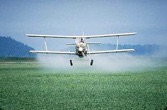Myths on hunger debunked:
Organic agriculture will never be able to feed the world
Myth 12: Organic agriculture will never be able to feed the world

Wrong.
Although this myth is not directly related to the issue of hunger but rather that of the capacity in the medium or long term of world agriculture to feed a growing population, the debate on the choice between an agriculture based on the use of chemical products (chemical fertiliser, pesticides and herbicides) and an agriculture that is less dependent on the use of chemicals containing fossil energy (ecological agriculture, organic agriculture) is relevant to the issue of world hunger.
This discussion may be structured in two parts
- Can an agriculture that is less dependent on chemicals feed the world?
- What effect would the development of such an agriculture have on world hunger?
On the first question, it is frequent to hear agricultural leaders, politicians, experts and representatives of big companies state that abandoning conventional “chemical” agriculture would imply a reduction of world agricultural production by 30 to 50%. Certainly, if conventional agriculture were abruptly replaced by an agriculture that does not rely on chemical inputs and that would not have adopted other agricultural practices, this would have immediate and devastating effects on food production. It would lead to crops suffering from deficiencies, which would be subject to all sorts of diseases and would be in competition with a wide array of competing weeds.
But that is not the alternative. The alternative is to replace conventional agriculture by an agriculture that uses management techniques for crops and for animal production based on the harnessing of ecological services, that are based on results of scientific research and of experiments implemented successfully throughout the world. This change would require extensive training of producers and a period of transition that would probably result in a slight reduction of production in the most intensively cultivated regions now using conventional agriculture. It would however replace existing agriculture by an agriculture that manages natural resources sustainably and produces less greenhouse gases. This replacement would take place essentially in industrial countries and would involve only a fraction of agriculture in non-industrial countries where smallholders generally only use small amounts of chemicals and where agriculture is relatively less productive. However, organic or ecological agriculture would contribute to increase substantially smallholder production. This increase would ultimately more than compensate for the possible decrease in production in industrial countries and would contribute to redistributing agricultural production in the world. Even in areas where agriculture uses chemical inputs moderately, the transition to an organic or ecological agriculture would contribute to increased production. This is what emerges from the documentation produced during the International conference on organic agriculture and food security held at FAO Headquarters from 3 to 5 May 2007. This is also supported by a study conducted by the International Food Policy Research Institute (IFPRI) according to which the adoption of organic agriculture would strongly increase agricultural production in Africa and would reduce food imports by the continent (Halberg 2006).
(in million tonnes)

Source: Badgley et al. 2007
On the second question, it is quite clear that the transition from conventional agriculture to organic or ecological agriculture would have a positive effect on the reduction of world hunger. This for three main reasons:
-It would create more employment in agriculture. This type of agriculture requires more labour and a more sophisticated management than conventional agriculture which is highly mechanised and where the fight against diseases, pests and weeds is done chemically, and soil fertility is managed by the application of chemical fertilizer. Soil fertility management and integrated pest management requires more labour than the techniques used in conventional agriculture. More labour means more employment, more income for labourers and therefore an improved capacity to have access to food.
-As the technologies used in ecological and organic agriculture use less purchased inputs, they are easier to adopt by poor farmers than those used in conventional chemical agriculture which requires the farmer to have the capacity to purchase inputs (improved and patented seeds, fertilizer, herbicides, fungicides and pesticides). They can also lead to the doubling (or more) of yields and of labour requirements, which contributes to more income. Small farmers would therefore see their production and their competitiveness improved considerably compared to the large producers. This would enhance their capacity to take part in the market, raise their income and improve their living conditions. Simulations conducted by researchers suggest that an increase by 10% of yields would reduce the number of poor in Sub-Saharan Africa by 7% (Byerlee et Alex, 2005).
-As ecological and organic agriculture tend to use multiple crops, often cultivated in association, this will reduce risks for the producer through diversification, contrary to conventional agriculture that mostly advocates monocropping that increases vulnerability to diseases and pests. Production under these alternative agricultures is more stable which contributes directly to the stability dimension of food security.
To conclude, it appears that conventional chemical-based agriculture is neither indispensable to feed the world, nor likely to resolve the issue of world hunger. Rather, the adoption on a large scale of ecological and organic agriculture is more likely to solve the issue of world hunger by securing sustainably sufficient food for the world population while safeguarding the planet’s natural resources. It would also reduce the impact of food production on the processes of climate change by cutting fossil fuel dependence.

Further readings:
-International Conference on Organic Agriculture and Food Security, FAO, Rome, 3 to 5 May 2007
-Christensen Fund’s diagram comparing in ecological agriculture with industrial agriculture
(October 2012)
Last update: September 2013
For your comments and reactions: hungerexpl@gmail.com
Thirteen myths about hunger:
4. Food aid
6. Africa
8. Poverty
10. Price volatility
12. Organic agriculture cannot feed the world
